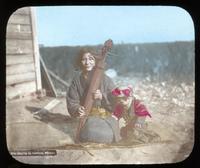Transmitting Tradition
Like many other Ainu-e works, the following scrolls show certain customs that would have been of particular interest to many Japanese viewers. Ainu Hunter Carrying Deer shows an Ainu man and women returning from a deer hunt. The man is dressed in a traditional attus robe and is wearing gaiters and fish-skin shoes, which offered waterproof protection against the cold. In front of him a woman carries what appears to be a tobacco kit. Men often would carve intricate patterns and designs on their tobacco pipes (kiseri) and boxes (tanpakuop) as a way to demonstrate their artistic abilities, and when meeting for the first time, was customary to exchange pipes and carefully inspect one another’s carvings.1
In Ainu Elder Conveys Traditions, two men sit on a woven mat. One offers libations of sake as the other sings or recites an epic poem called a yukar, while playing a stringed instrument called a tonkori (just like the woman in the photo below).
As an oral culture, songs and dances play a vital role in passing down knowledge from one generation to the next. Often accompanied by music played on the tonkori zither and mukkuri mouth harp, these dances and songs are deeply rooted in ceremonies meant to pray for good fortune and ward off evil spirits.2 Yukar, meanwhile, relay the history and legends of Ainu Mosir—the Ainu homeland—and are full of kamuy, mythological heroes, and historical figures. These stories, often told in the first-person from the perspective of the protagonist,3 range from comical, short, didactic lessons to long narratives told over multiple nights and involving participation from all members of the community.4 Today, some of the best-known yukar come from the Ainu shinyōshū, a collection of Ainu tales first told by Imekanu (Kannari Matsu, 1875-1961) and recorded and translated into Japanese by her niece Yukie Chiri (1903-1922). While the rapidly decreasing number of Ainu speakers has had a profound impact on the transmission of traditional knowledge, thanks to the efforts of Chiri, Imekanu, and other elders in the community, these yukar are being preserved and continue to be passed down, keeping these histories alive for future generations.
1.) Chisato Dubreuil “Ainu Art: The Beginnings of Tradition,” Ainu: Spirit of a Northern People, 298.
2.) Kazuyuki Tanimoto, “To Live is to Sing,” in Ainu: Spirit of a Northern People, 283.
3.) Typically an animal kamuy or the folk hero Okikurumi.
4.) Mie Oginaka, “Yukar: Epics of Heroes,” in Ainu: Spirit of a Northern People, 280.


